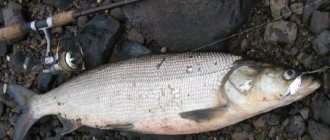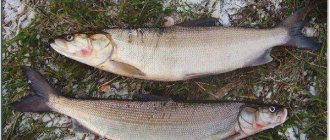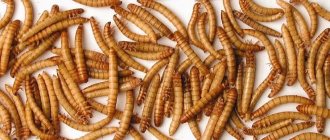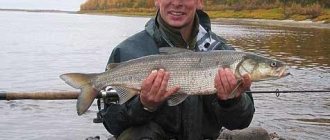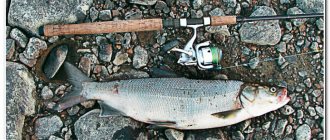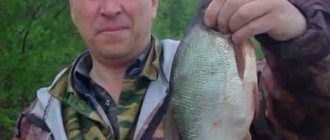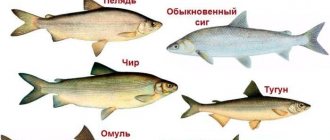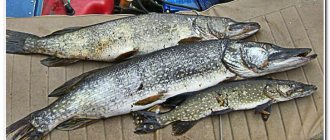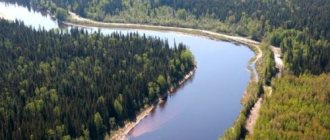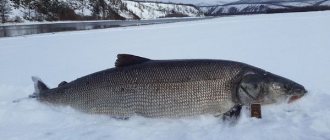Habitats
In a broad sense, these are the giant Siberian rivers: the Ob, Yenisei, Lena and their large tributaries, such as the Irtysh. The three listed above flow into the Arctic Ocean, where near the coasts and at the mouths of rivers flowing into narrow bays, the so-called. lips, and schools of nelma live. The ideal, from the point of view of this fish, is a mixture of salt and fresh water, or sea water of low salinity - no more than 20 ppm.
In late spring and early summer, depending on the onset of ice drift, adult (from 6 years old) nelma rush into fresh waters to spawn. They reach their spawning grounds in the middle and upper reaches of rivers, traveling about a thousand kilometers, spawn and return to the sea in the fall. Over the next year, the water current gradually carries the hatched fry there, although some may linger in fresh water for a year or two.
Fishing for nelma is carried out only in the river; it is not caught in the sea.
This is a Red Book species. However, there is no penalty for accidentally catching whitefish as bycatch when the hunt was for completely different prey.
In a narrow sense, habitats include sections of rivers where this fish likes to stay. Nelma approves only of clean running water, appreciates rapids and often the small quiet bays adjacent to them, where small white fish, its main prey, like to feed. Like any predator, you need to look for it where the prey may be:
Photo 1. Perches are frequent victims of larger predators.
White salmon fry can pick up insects from the surface of the water. This fish generally tends to stay near the surface or at a shallow depth, up to two meters, because it is not an ambush, but a driven predator that requires space.
Nelma can feed near the riffles, where the water is bubbling, washing small fish out of hard-to-reach places, but not in the riffles themselves. You can also try to look for it near shallows with a pebble or sandy bottom, located not near the shore, but closer to the middle of the river.
Fishing for nelma on the Ob, for example, is most effective along the steep right bank. The left, Western Siberian coast is shallow water and floodplain, an unsuitable place for nelma. The same principle can be applied to the rest of the Siberian rivers flowing to the north.
The whitefish loves areas where rock spits abruptly drop into the depths, and there may be large washouts under the water. But, nevertheless, the fundamental principle for the silver predator is always preserved: a pebble or sandy bottom.
Spreading
Being a semi-anadromous and freshwater fish, it swims in rivers belonging to the Arctic Ocean basin. Nelma is a frequent visitor to the Yenisei. Also, fishing for this fish is popular in the mouths and deltas of such rivers in the Siberian region as:
- Ob.
- Irtysh.
- Lena.
The beginning of ice drift is marked by the movement of salmon from the Arctic Circle to spawning grounds. These are the middle and upper reaches of the rivers. The fish begin to move upstream most intensively by mid-July.
At the beginning of autumn, flocks of nelma reach the southeast of Siberia, where they stop in numerous rivers. But for spawning, the fish does not prefer the first river it comes across. As soon as it enters the mouth of the river, it tries to stay closer to the bottom, while moving along the river flow. Further advancement often occurs in the upper layers of water. The fish tries to avoid shallows and riffles.
Moving along the river to the spawning ground, nelma feeds on a large number of small fish. During morning and evening feeding, nelma rises to the upper and middle layers of water. White salmon feeds in almost the same way as sheresper, suddenly bursting into a school of small fish, drowning them with its fin, and then collecting the confused river inhabitants.
While fishing, even experienced fishermen sometimes flinch from the splash on the river that nelma creates. Perhaps there is no other fish on the Yenisei that could make such a loud and amplitude splash . The splash can be heard very close to the shore, not far from a bush or snag where the fry are kept, or in a wide, calm bay with a moderate current.
Fishing methods
How to catch nelma? The main production tool is a spinning rod for long-distance, 12-18 m casts. In those days when fishing with spinning gear in nelma habitats was not common, homemade gear for hand casting was used for fishing. There are two main types of tactics: either promising areas where fish may be located are targeted, or they are caught “by splash” - the lure is sent to where the tail of the fish has just splashed. The place where the spoon is splashed onto the nelma should be a couple of meters further than the splash, so as not to scare it.
If the whitefish does not openly strike with its tail, but there are suspicions that it is found in this place, the selected point is fished clockwise, roughly from 11 to 14 o’clock on the dial. Wiring speed is average. You need to focus on the speed of movement and behavior of the medium-sized white peaceful fish, which serves as the basis of the menu. You may need to experiment with speeds. Good results in a place where there was no bite at all can be achieved by simply changing the speed of the retrieve.
Where does nelma live?
The marine subspecies of nelma lives in cold waters throughout the entire Russian Arctic region, as well as in large Siberian rivers:
- Ob:
- Yenisei;
- Lena;
- Irtysh.
This fish prefers to spend the winter at the mouths of large rivers. With the beginning of ice drift, the fish begin to rise upstream. By mid-June, it reaches the headwaters of large rivers and disperses along small taiga rivers for spawning.
All this time, the fish feeds in the middle layers of water and near the surface. It usually attacks from an ambush, usually from behind a flooded bush or snag. Appears near the shore and in large river bays. The main condition is the presence of fry in this place.
Nelma can almost never be found near shallows and riffles. In the river, when moving to spawn, it tries to stay in the upper layers of water.
Spinning and equipment
Nelma can be successfully caught using a spinning rod if the spinning rod itself and its equipment are well selected. The issue of choosing gear must be approached very responsibly, because if you are not a resident of the Far North, you will have to go very far to get this fish. It is recommended to have two or three spinning rods with you:
- heavy - dough up to 60 g;
- medium - up to 25 g;
- light - up to 14 g.
Photo 3. Light spinning rod.
The main one, most likely, will be a medium spinning rod, since nelma, although large - it is generally prohibited to catch individuals less than 59 cm in length - is a weak opponent. After several strong jerks there will be no resistance, you can pull it ashore with a net and your hands, the load on the rod and line will not be extreme.
A heavy long-range spinning rod can be useful for long-distance casts, or if you have set yourself the task of definitely catching a trophy specimen. It can be more than a meter in length and weigh 20-30 kg.
Particular attention should be paid to the coil - it should be:
- Inertialess.
- Frictional.
- With a large spool diameter - for 200 meters of cord and backing.
- Powerful - the load on the main mechanism is permissible at least 9 kg.
The gear ratio is less important.
Which fishing line is better to take? Any fishing line can be used - monofilament or braided line, the main thing is that the breaking load must be at least 9 kg. The fish will not fight desperately, but fishing is carried out in conditions of increased difficulty, and the fishing line may break on sharp stones. Therefore, many believe that a stronger cord is preferable. It is recommended to take a bright one - it is better visible in the water, but the fish don’t care.
Hooks should be small, but strong and made of good steel.
Fishing Features
Fishing for nelma by amateur fishermen and athletes is allowed only in its permanent habitat - the Far North - and only with a spinning rod. The use of nets, especially fixed ones, is permissible only for industrial fishing; in other cases it is poaching.
Fishing is carried out either in July-August, when the fish have not yet gone to spawn, or in winter and early spring, when the ice has not yet melted. But winter fishing in most cases is considered poaching.
Taking it with a spinning rod in permitted places is the only correct option. The peculiarity of catching nelma is that it cannot be fished with a spinning rod. The hook must be quick during any attempt to bite, since the white fish often leaves the hook, even from the tee, due to the peculiarities of the prey’s grip. The caught fish makes several strong jerks, which must be dampened by the clutch and the rod as a whole, and then it is calmly given into the hands.
The pulled out prey must be placed in a container with ice or a thermal bag as soon as possible, since without water it dies within a few minutes. In this case, bleeding from the wound from the hook and gill slits is often observed, since there are many blood vessels on the nelma’s face.
Catching nelma
Catching nelma
When catching nelma, you must take into account that it is shy and careful. Her defensive actions are very energetic and strong. Nelma is a rheophile, that is, it always stands in the water with its head against the current. To live, she needs only clean and running water. When taken out of the water, nelma is fragrant with the smell of fresh cucumbers. White salmon dies without water in just a few minutes and bleeds heavily through the gills.
Nelma are caught on spinners and large narrow-bodied spoons, usually silver in color, matching the color of the fry of smelt or vendace, which the nelma are accustomed to feeding on. Basically, nelma is caught, like ide, in the upper and middle water horizons at a depth of up to 2 meters from the surface, or even near the surface. This is a typical feeding level for nelma.
Evening fishing is often worse than morning fishing. Catching nelma at night is unlikely. Sometimes it is caught during the day, but on quiet and cloudy days. Nelma resists very energetically. But, having made several sharp throws, he is completely exhausted, lies down on his side and allows himself to be calmly picked up by the landing net.
All salmon species of commercial importance are under special protection of the state, therefore fishing for nelma is prohibited in all southern and central regions of Siberia. The exception is the northern outskirts of Siberia, where nelma is harvested industrially by fishing cooperatives and then sold throughout the country. But very often, amateur fishermen catch nelma as bycatch while catching other fish. It is quite difficult to catch salmon in the south of Siberia with sports gear - its concentration is not as high as, say, in its permanent habitat, for example, in the Ob delta. In those places, fishing for nelma is allowed and you can successfully catch it there with a spinning rod.
Unfortunately, recently in the Siberian and Northern Ural rivers there has been much less of it than before, and this is not only due to poachers, although they also make a significant contribution: salmon are caught en masse and uncontrollably, and it is becoming increasingly difficult for them to reproduce - places There are not many places left to spawn safely. Many hydroelectric power stations have been built on the rivers of Siberia, and people need more and more electricity - more than half of the areas for fish spawning have already been cut off, and in the remaining places the water has become dirty; salmon spawn - like all salmon - only in clean and clear water. Of course, they are trying to breed it artificially, but so far this has not worked out very well: nelma fry do not survive well in captivity.
But this fish is a valuable commercial species, and is strictly protected: it is strictly prohibited to catch it industrially in Russia, precisely because it has begun to reproduce worse, and only in one region - in the northern part of Siberia - are artels of fishermen operating legally. Catching nelma in other territories is possible only through bycatch, when it ends up in nets along with other fish.
Probably the situation will change for the better in the near future, since the meat of this fish is characterized by high taste qualities, which make salmon a promising object for commercial fish farming.
Time and place for fishing
This fish enters small rivers in the summer and moves to the spawning grounds, which takes place in the fall. Some individuals remain in these tributaries and live there for up to 3 years. Fishing for nelma is carried out in the taiga, distant rivers, where there are no roads and the place can only be reached by boats.
Fishermen manage to catch salmon on rivers such as the Oka and Yenisei. The fish is rare, it lives in clean water and feeds on the surface of the river. Therefore, it must be caught using baits that are used in the surface layers of the reservoir.
How to catch nelma? Nelma is a large fish; it can hunt for fry near the shore. Young nelma prefer to catch fallen insects.
Fish near the riffles when the high water ends. The fish lives not only in the upper sections of rivers, but also in deep-sea pits. It is best to fish early in the morning and late in the evening. The best bite happens at times like this.
Habitats of nelma
Nelma or white fish
Nelma fish is one of the many relatives of the Siberian celebrity - omul. However, not as close as, for example, whitefish or whitefish. Rather, this fish is a cross between omul and salmon. The closest relative of nelma is the white fish. Some scientists even propose combining these two fish into one species. But they are still different and differ primarily in their habitats. The whitefish loves warm and calm waters. It lives in the middle zone and in the south of the European part of Russia and the Urals. But nelma behaves completely differently. She, on the contrary, prefers cold and harsh waters, so they are not so similar to the whitefish.
The main habitat of nelma fish is Siberia. If you already know something about omul and its relatives, then this fact will hardly surprise you. Siberia is a real paradise for whitefish, and nelma fish is no exception. However, unlike many of its relatives, it is not limited to the territory of Siberia and the Far East alone. If omul, broad whitefish, muksun and other whitefish are found only in rivers connected to Baikal and the Arctic Ocean, then the distribution area of nelma is much wider.
This fish also finds refuge in rivers connected to the Pacific Ocean and this immediately stands out among its close and not so close relatives. In addition, it is found on another continent. So our country cannot boast that there is no such fish as nelma anywhere else. It is also found in rivers in Canada and the USA (Alaska). In these zones, the climate is very similar to the climate of Siberia, just as cold and harsh, and this is exactly what the nelma needs.
If we talk about the habitats of nelma fish more specifically, then it is found in almost all rivers located beyond the Arctic Circle. In the west, the habitat of this fish is limited to the Ponoy and Onega rivers, in the east (already on the North American continent) – to the Yukon and Mackenzie rivers. Of course, it cannot be said that fish are distributed evenly across these reservoirs, on the contrary. Somewhere there is quite a lot of it (for example, in the Northern Dvina River and some lakes associated with it: Zaisan, Norilskoye, Kubenskoye), and somewhere it is found literally in single copies.
This uneven distribution is associated with many factors. The climate, which is not always the same at the same latitudes, the types of rivers (fast or slow), and, of course, the ecology also play a role here.
Ecology in general has a significant impact on the habitat of nelma. For example, half a century ago it was found in abundance in the Ob River and its tributaries, for example, in the Biya, Charysh, Peschanaya, Anuya and others. And then the Ob was blocked with a dam, and the number of nelma decreased tenfold. If earlier this fish was caught there almost on an industrial scale, now it is necessary to keep the catch under strict control, since its quantity has decreased almost to a critical level.
The same can be said about other rivers of Siberia and the Far East. In some places, the reason for the reduction in the number of nelma fish was environmental problems, in others hydroelectric power plants were to blame, in others they were simply caught uncontrollably for a long time. Today, the number of nelma has decreased so much that scientists are already beginning to sound the alarm. In some areas, this fish has already been banned from being caught in any quantity.
If we talk about the habitats of nelma in general, then, as you probably already guessed, it prefers rivers, and the rivers are calm and wide.
She doesn’t disdain lakes either. Some scientists are even trying to divide nelma fish into two groups: lake-river and river, like whitefish or muksun. One group, accordingly, lives in lakes and goes into rivers to spawn, the other lives and spawns in the river, but in different places. By the way, this feature is inherent in all whitefish. Nelma fish
The main food for nelma fish are crustaceans, insect larvae, and fish fry. They are most numerous in those parts of the river where the current is not very strong. That is why the nelma fish prefers to stay there. In lakes, she chooses places near the mouths of rivers, because they bring with them silt with crustaceans, larvae and other “products”.
But nelma spawn exclusively in rivers. In the fall, fish gather in schools and go on a long journey upstream, to where the water is a little warmer. The eggs are spawned in areas with a flat sandy or rocky bottom, and the fish return back. In total, this journey takes about six months, and therefore it does not spawn every year.
Today, nelma fish is considered a delicacy. It is famous for its tender meat with a lot of fat. Unfortunately, this does not benefit its numbers. The habitat of this fish is gradually narrowing, and even where it still remains, there is not as much of it as there once was. However, catching this fish is still allowed in some areas, albeit in limited quantities. This means that you have the opportunity to try this yummy.
Features of catching nelma using a spinning rod
The most convenient way to catch nelma is considered to be a spinning rod for long-distance casting. Fish can be caught using a spinning rod when the form and its equipment are selected correctly. You need to choose your gear wisely, because you will have to travel far to catch fish. You need to take 3 spinning rods with you: heavy, medium and light. The average spinning rod is considered the main one, because nelma is a large but weak predator.
After several jerks, the nelma stops resisting, it can be pulled ashore, the load on the fishing rod and line will not be too great. A powerful spinning rod is used for long-distance casting if you want to catch a fairly large specimen: more than a meter long and weighing up to 30 kg.
Experienced fishermen advise fishing for nelma by fishing a large area. From the first riffle to the subsequent ones, you need to swim in a boat in the direction of the current.
For one, such fishing is difficult; several people must search for prey. The tactics are as follows: a boat with a crew leaves, leaving one person at each next suitable place. As a result of exploration, you can find areas where the most effective catch will be.
There is a rule for fishing: the lower the water level in the river, the better the nelma bite. When it rains in the summer and there is a lot of water in the river, the catch will be poor.
Rod and equipment
Spinning should not be too powerful. The fish hardly resists, so even a thin spinning rod will not break. But for catching large specimens, they choose a medium-class spinning rod. You need to take a light rod weighing 7-14 g, a medium one weighing 15-20 g and a powerful one weighing up to 60 g.
Since fishing is most often carried out on unfamiliar rivers, you need to prepare carefully. Cords for rigged spinning rods are good, but the best thread is monofilament, it has excellent shock absorption. You need to use a leash 20 cm long.
Instead of a thick thread, which is blown away by the wind when casting, take a thin, smooth cord. The color of the braided cord is not important, because... the fish doesn't notice him. This makes it possible to use a bright, clearly visible cord, with which it is easy to follow the bait when wiring.
The coils must be well adjusted. Provide a large supply of fishing line on the spool; when an individual bites, you need to unwind it.
Coil requirements:
- They must be a durable mechanism that can withstand heavy loads.
- The gear ratio should be 5:1.
- The spool is designed for 150 m of 0.1 mm thick cord.
For taiga fishing for salmon far from home, do not forget to take spare gear with you so that the time spent on preparation and travel is not wasted.
WHITE FISH, OR NELMA

White fish, or nelma - Stenodus leucichthys
Salmon family - Salmonidae
There are two subspecies: whitefish (Stenodus leucichthys leucichyhys) from the Caspian Sea basin and salmon (Stenodus leucichthys nelma) from the rivers of the Arctic Ocean. The origin of the species is Arctic. The whitefish entered the Caspian Sea from the Arctic Ocean basin during the Late Ice Age.
Nelma is a river fish, avoids sea waters and can appear in brackish waters only during the feeding period. Does not form a flock. It grows over a wide range of water temperatures (12–24° C). Distributed in all rivers of the Arctic Ocean basin from the White Sea (Kem and Ponoi rivers) to Chukotka, in America to the Yukon and Mackenzie rivers.
Whitefish is a migratory, cold-loving fish. Lives in the Caspian Sea, migrates along the Volga to reproduce and concentrates near the dam of the Volgograd hydroelectric station. Single specimens enter the Ural River. In the Caspian Sea, it lives mainly in the Northern and Middle Caspian, less often in the Southern (at a depth of 65 m).
The body is elongated, laterally compressed. The head is relatively small. The mouth is terminal, oblique; the upper jaw does not reach the vertical of the posterior edge of the eye. The teeth on the jaws are very small, almost invisible. The scales are large. Nelma reaches a length of 150 cm and a weight of 28 kg (occasionally up to 40), matures at the age of 9–15 years with a length of 70 cm or more. The whitefish is somewhat smaller - a maximum of 130 cm and 14 kg; females reach sexual maturity in the sixth - seventh year, males in the fifth - sixth.
The only whitefish species that leads an exclusively predatory lifestyle; switches to feeding on fish after reaching a length of 30 cm. Juveniles feed on insect larvae, mysids and juveniles of other fish species. Adult nelma consumes mainly juvenile whitefish (cidaceae, omul, tugun, whitefish), carp and perch fish. The whitefish feeds mainly on sprat, silverside, juvenile herring, roach and gobies.
When traveling from feeding grounds and wintering grounds to spawn, nelma rise upstream of rivers to a distance of up to 3,500 km from the mouth. The spawning season begins under the ice and continues throughout the summer. Spawning at the end of September - October, not annually (interval 3-4 years). The eggs develop between the stones. The incubation period is about 6 months. The migration of juveniles begins in April. The length of the fingerlings is 7–13 cm.
In whitefish, spawning occurs mainly in November and partly in December at a water temperature of 5 ° C and below on spawning grounds near Golodny Island near the Volgograd hydroelectric power station dam, where the substrate is sand with a slight admixture of dead mollusk valves. Artificial rocky and pebble spawning grounds are being created in this area, which will increase the efficiency of natural reproduction. In the past, the whitefish, after spawning in the upper reaches of the river, died from exhaustion and practically reproduced once during its life (10–11 years). Nowadays, thanks to the reduction of the spawning range, the number of 8–11-year-old females that spawn again has increased.
Catching baits for nelma
The best baits for catching nelma are spinners weighing 9-14 g, their color should be silver, close to the shade of the fish itself. Nelma are caught well with a Scale spinner; Mepps Aglia and Kastmaster spinners are also considered high quality. Many fishermen use Devons, fishing with narrow rotating baits. The baits are chosen medium so that the fish can grab them.
The following types of bait are also suitable for fishing:
- silver-colored oscillating spoons;
- streamers;
- wobblers.
When wondering how to catch nelma, it should be noted that you should buy medium-sized spoons, because the fish has a small mouth, and it always captures prey across the body. Baits and fastenings should be small but strong, the spoon should be attached to a leash. After connecting all the elements, make sure the entire structure is strong and only then start fishing.
Fishing tactics
There are 2 ways of fishing:
- Possible fish habitats are subject to targeted fishing.
- Fishing with a splash, the spoon is thrown to where the fish tail surfaces.
In order not to scare the fish, you need to throw the bait 2 m further than the splash. If salmon does not appear, but you know that it lives here, the selected area is fished in a circle. In this case, a low wiring speed should be used.
You need to focus on the speed of movement of the average fish. You should also try experimenting with speeds. An excellent result where there is no bite can be achieved by changing the speed of the retrieve. Experienced fishermen often use this method.
Features of fishing
The fish does not resist for a long time, but since it has no teeth, it can fall off the hook. When fishing with a spinning rod, the nelma most often grabs the bait across and a runaway may occur. There is no need to pull the fish with a spinning rod; it is better to use a net and throw it onto land with your hands.
In a cold wind, nelma will not bite, and fishing will be unsuccessful. Catching nelma is allowed only with spinning rods in its habitat - in the north. The use of nets is allowed for industrial fishing; in other situations it is considered poaching.
Fishing occurs in the summer, when salmon does not yet swim to the spawning site, or in winter and early spring, when the ice has not melted. Catching nelma in winter is complicated by severe frosts. You can fish under the ice. Most fishermen who put gear on salmon in winter note a fairly high catch.
The hook must be done quickly with each bite. The caught individual makes several jerks, they need to be extinguished with a reel and fishing rod, and then it can be safely pulled out.
The caught fish must be immediately placed in a container with ice, because without water it will die in a few minutes. At the same time, she often bleeds from a hook injury, since there are many arteries located on the fish’s mouth.
Catching nelma in winter or how they used to catch nelma
Preface
My father-in-law was an avid fisherman, he lived near the Ob River and told me that, before the construction of the dam on the Ob, there was a lot of different fish that could be caught without much difficulty. Among other fish there was nelma, both medium-sized and large. Catching nelma in winter was exciting and interesting.
Fig 1
How they used to catch nelma
He caught nelma in winter in the following way. He took a thin piano wire and tied a three-meter leash made of fishing line at one end of it, at the end of which a homemade stainless steel spoon was attached. The length of the wire was such that it passed through the thickness of the ice and another meter into the water. At the other end of the wire, he bent a ring into which he inserted a small stick along a length greater than the diameter of the hole.
Fig 2
He hollowed out the hole with an ice pick, set up the tackle, covered the hole with wooden planks and covered it with snow. The wire that went under the ice served as a spring. , thanks to the spring wire and the current, it played all the time and attracted fish.
Dangerous fishing
The construction of a hydroelectric power station in 1950 on the Ob River cut off the path to the spawning grounds of such fish as Siberian sterlet, nelma, muksun, and peled. The fish went to the upper reaches to spawn and ran into the dam.
Fig 3
Fishermen took advantage of the fact that there was a lot of fish near the dam, although a 500-meter ban on fishing near bridges, dams, and dams was introduced. A colleague worked with me who was literally obsessed with fishing.
He did the following: he took with him a winter fishing rod for trolling nelma, changed into a white robe so that the dam guards would not notice him on the ice, and drove to the dam. Since the ice was thin closer to the dam, it was impossible to walk on it, so it crawled further.
He crawled to the desired area, punched a hole with a knife and caught salmon while lying down with a winter fishing rod. He pulled her onto the ice and crawled back. He risked his life, because if you fall through the thin ice, you won’t be able to climb on.
Fig 4
Other fishermen, see photo, also caught salmon downstream, jumping from ice floe to ice floe, and also risked falling through the ice. Currently, there is a ban on fishing closer than 1.5 km. from the dam.
Source: Mine
© Porsev Yu.I.
A must read!!!
Materials on the site are posted in accordance with the conditions presented on the “Terms” page.
The publication posted on this page is solely an expression of the personal opinion of its author! The author is listed next to the title of the publication.
This material is in no way associated with the site staff or its owner and was not discussed with them before publication!
If this publication violates your rights, please go to the “Contacts” page and follow the instructions there.
Time and place for fishing
This fish enters small rivers in the summer and moves to the spawning grounds, which takes place in the fall. Some individuals remain in these tributaries and live there for up to 3 years. Fishing for nelma is carried out in the taiga, distant rivers, where there are no roads and the place can only be reached by boats.
Fishermen manage to catch salmon on rivers such as the Oka and Yenisei. The fish is rare, it lives in clean water and feeds on the surface of the river. Therefore, it must be caught using baits that are used in the surface layers of the reservoir.
How to catch nelma? Nelma is a large fish; it can hunt for fry near the shore. Young nelma prefer to catch fallen insects.
Fish near the riffles when the high water ends. The fish lives not only in the upper sections of rivers, but also in deep-sea pits. It is best to fish early in the morning and late in the evening. The best bite happens at times like this.
Features of catching nelma using a spinning rod
The most convenient way to catch nelma is considered to be a spinning rod for long-distance casting. Fish can be caught using a spinning rod when the form and its equipment are selected correctly. You need to choose your gear wisely, because you will have to travel far to catch fish. You need to take 3 spinning rods with you: heavy, medium and light. The average spinning rod is considered the main one, because nelma is a large but weak predator.
After several jerks, the nelma stops resisting, it can be pulled ashore, the load on the fishing rod and line will not be too great. A powerful spinning rod is used for long-distance casting if you want to catch a fairly large specimen: more than a meter long and weighing up to 30 kg.
Experienced fishermen advise fishing for nelma by fishing a large area. From the first riffle to the subsequent ones, you need to swim in a boat in the direction of the current.
For one, such fishing is difficult; several people must search for prey. The tactics are as follows: a boat with a crew leaves, leaving one person at each next suitable place. As a result of exploration, you can find areas where the most effective catch will be.
There is a rule for fishing: the lower the water level in the river, the better the nelma bite. When it rains in the summer and there is a lot of water in the river, the catch will be poor.
Rod and equipment
Spinning should not be too powerful. The fish hardly resists, so even a thin spinning rod will not break. But for catching large specimens, they choose a medium-class spinning rod. You need to take a light rod weighing 7-14 g, a medium one weighing 15-20 g and a powerful one weighing up to 60 g.
Since fishing is most often carried out on unfamiliar rivers, you need to prepare carefully. Cords for rigged spinning rods are good, but the best thread is monofilament, it has excellent shock absorption. You need to use a leash 20 cm long.
Instead of a thick thread, which is blown away by the wind when casting, take a thin, smooth cord. The color of the braided cord is not important, because... the fish doesn't notice him. This makes it possible to use a bright, clearly visible cord, with which it is easy to follow the bait when wiring.
The coils must be well adjusted. Provide a large supply of fishing line on the spool; when an individual bites, you need to unwind it.
Coil requirements:
- They must be a durable mechanism that can withstand heavy loads.
- The gear ratio should be 5:1.
- The spool is designed for 150 m of 0.1 mm thick cord.
For taiga fishing for salmon far from home, do not forget to take spare gear with you so that the time spent on preparation and travel is not wasted.
Methods of catching whitefish
Hunting for this fish may differ in different regions, both in terms of the set of gear and the fishing season. White fish Nelma is caught using a variety of gear, but amateur species include spinning, fly fishing, float rod, trolling or track.
Catching nelma white fish with a spinning rod
Fishing for nelma in Siberian rivers may require some experience and patience. All experienced fishermen say that it is very important to determine the fishing location. In addition, the fish is very careful and picky about bait. As always, it is worth noting that catching big fish requires reliable gear. When fishing for nelma, it is necessary to use only certain baits. Nelma whitefish feeds on young fish; wobblers and spinners should be small in size. Therefore, tests of spinning rods must correspond to baits, preferably up to 10-15 g. It is better to choose a medium or medium-fast rod action, which allows for longer casting and comfortable landing of lively fish. The length of the rod should correspond to the size of the river and fishing conditions.
Fly fishing for nelma whitefish
Nelma responds well to fly baits. Basically, these are small individuals. The choice of gear depends on the fisherman, but it is worth considering that the best results in catching nelma will be achieved by fly fishermen who know how to make long casts. Gear 5-6 classes can be considered optimal. Perhaps using long-bodied cords with the most delicate presentation possible.
Catching nelma white fish with other gear
Large specimens of whitefish respond best to natural baits, especially live bait and rigs with “dead fish”. Spinning rods or “long casting” rods are great for this. At certain times, the fish bite well on float tackle with a nozzle made of a worm, a bunch of bloodworms or maggots. And yet, for sport fishing for large Caspian white fish, using live bait or a tackle with fish can be considered the most catchy way.
Catching baits for nelma
The best baits for catching nelma are spinners weighing 9-14 g, their color should be silver, close to the shade of the fish itself. Nelma are caught well with a Scale spinner; Mepps Aglia and Kastmaster spinners are also considered high quality. Many fishermen use Devons, fishing with narrow rotating baits. The baits are chosen medium so that the fish can grab them.
The following types of bait are also suitable for fishing:
- silver-colored oscillating spoons;
- streamers;
- wobblers.
When wondering how to catch nelma, it should be noted that you should buy medium-sized spoons, because the fish has a small mouth, and it always captures prey across the body. Baits and fastenings should be small but strong, the spoon should be attached to a leash. After connecting all the elements, make sure the entire structure is strong and only then start fishing.
Fishing tactics
There are 2 ways of fishing:
- Possible fish habitats are subject to targeted fishing.
- Fishing with a splash, the spoon is thrown to where the fish tail surfaces.
In order not to scare the fish, you need to throw the bait 2 m further than the splash. If salmon does not appear, but you know that it lives here, the selected area is fished in a circle. In this case, a low wiring speed should be used.
You need to focus on the speed of movement of the average fish. You should also try experimenting with speeds. An excellent result where there is no bite can be achieved by changing the speed of the retrieve. Experienced fishermen often use this method.
Features of fishing
The fish does not resist for a long time, but since it has no teeth, it can fall off the hook. When fishing with a spinning rod, the nelma most often grabs the bait across and a runaway may occur. There is no need to pull the fish with a spinning rod; it is better to use a net and throw it onto land with your hands.
In a cold wind, nelma will not bite, and fishing will be unsuccessful. Catching nelma is allowed only with spinning rods in its habitat - in the north. The use of nets is allowed for industrial fishing; in other situations it is considered poaching.
Fishing occurs in the summer, when salmon does not yet swim to the spawning site, or in winter and early spring, when the ice has not melted. Catching nelma in winter is complicated by severe frosts. You can fish under the ice. Most fishermen who put gear on salmon in winter note a fairly high catch.
The hook must be done quickly with each bite. The caught individual makes several jerks, they need to be extinguished with a reel and fishing rod, and then it can be safely pulled out.
The caught fish must be immediately placed in a container with ice, because without water it will die in a few minutes. At the same time, she often bleeds from a hook injury, since there are many arteries located on the fish’s mouth.
Fertility and spawning
Males of nelma reach a length of up to 110 cm, females - up to 130 cm, live more than 20 years. In the Ob River they become sexually mature in the 13th-14th year, in the Yenisei - in the eighth-tenth year. Fertility from 134 thousand to 422 thousand eggs. The duration of spawning of nelma fish is 9-16 days.
Nelma caviar is bottom, non-sticky, egg diameter is 2.5 mm. Incubation of nelma eggs lasts about six months.
Some of the underyearlings migrate to the lower reaches, into delta areas, in the first year of life, while the rest linger near the spawning grounds for up to two years or more.
Nelma migrates from wintering and feeding grounds to spawning grounds. At the mouths of the Tom, Biya and Katun rivers, artificial breeding of this fish was used.

Photo of caught nelma
